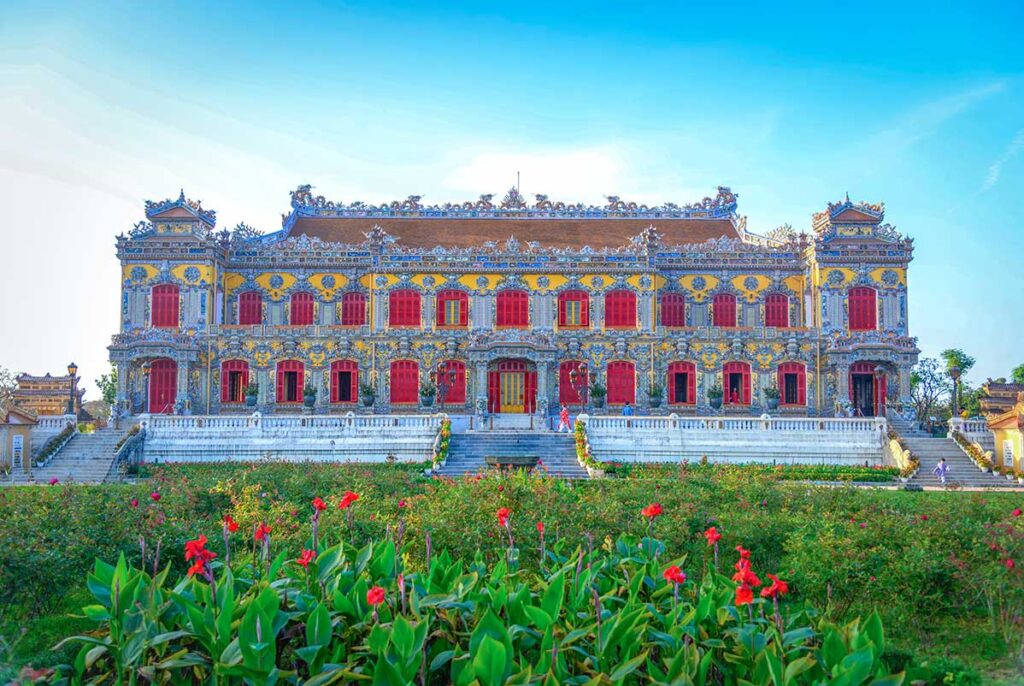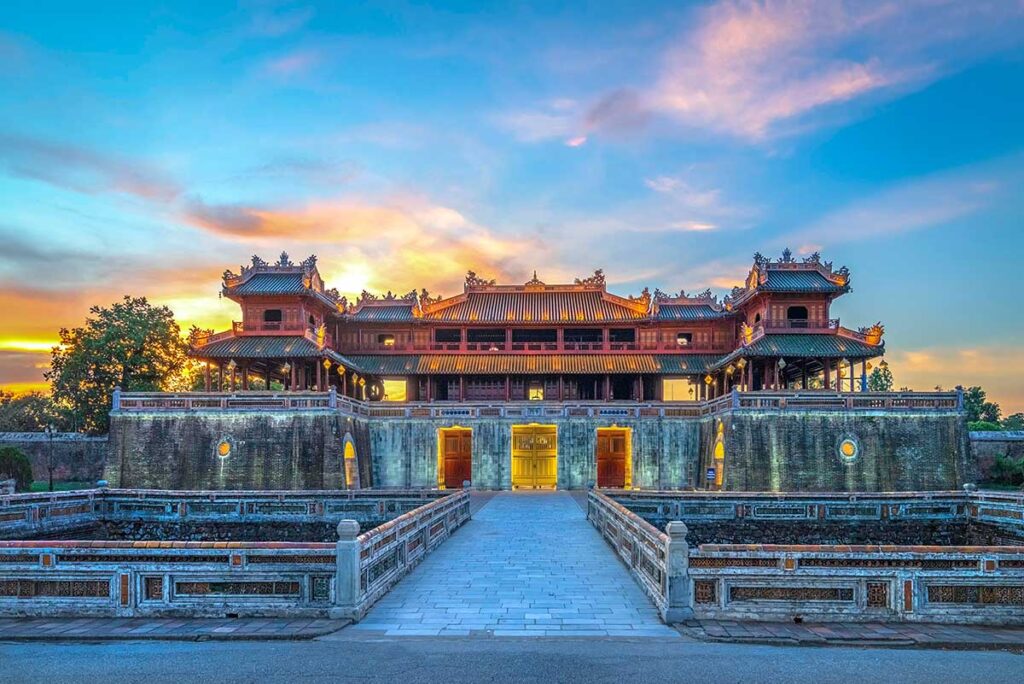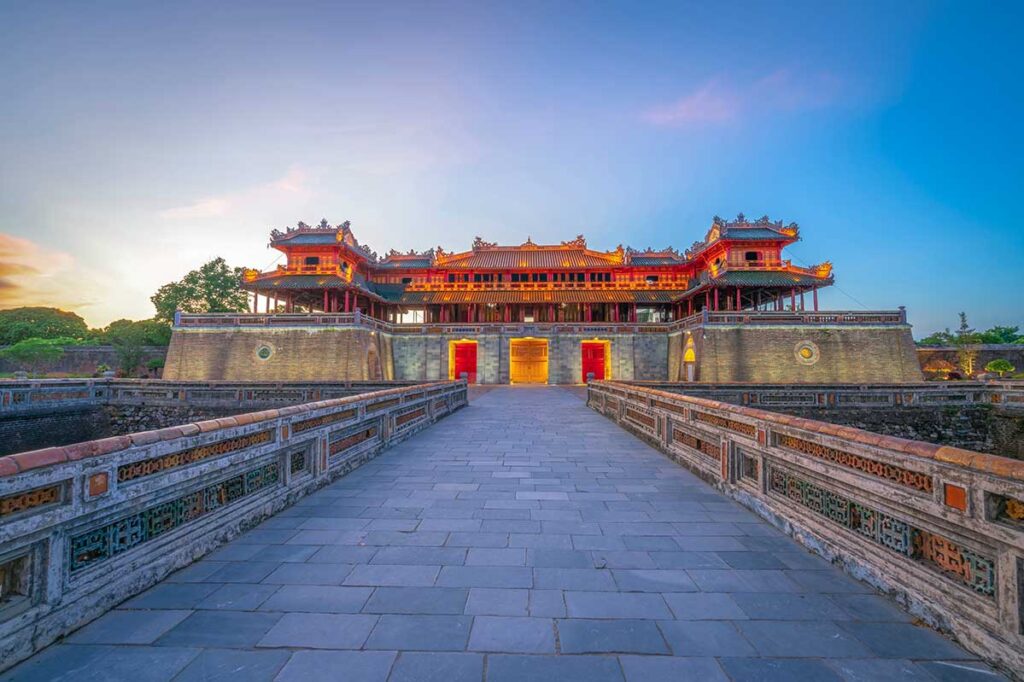What is Kien Trung Palace?
Kien Trung Palace is a restored royal residence inside Hue’s Forbidden Purple City, part of the Imperial City complex. It was first used by Emperor Khai Dinh in the early 1920s and later by his successor, Emperor Bao Dai, making it the home of Vietnam’s last two emperors. The design is unusual for Hue, combining French and Italian Renaissance influences with traditional Vietnamese royal architecture.
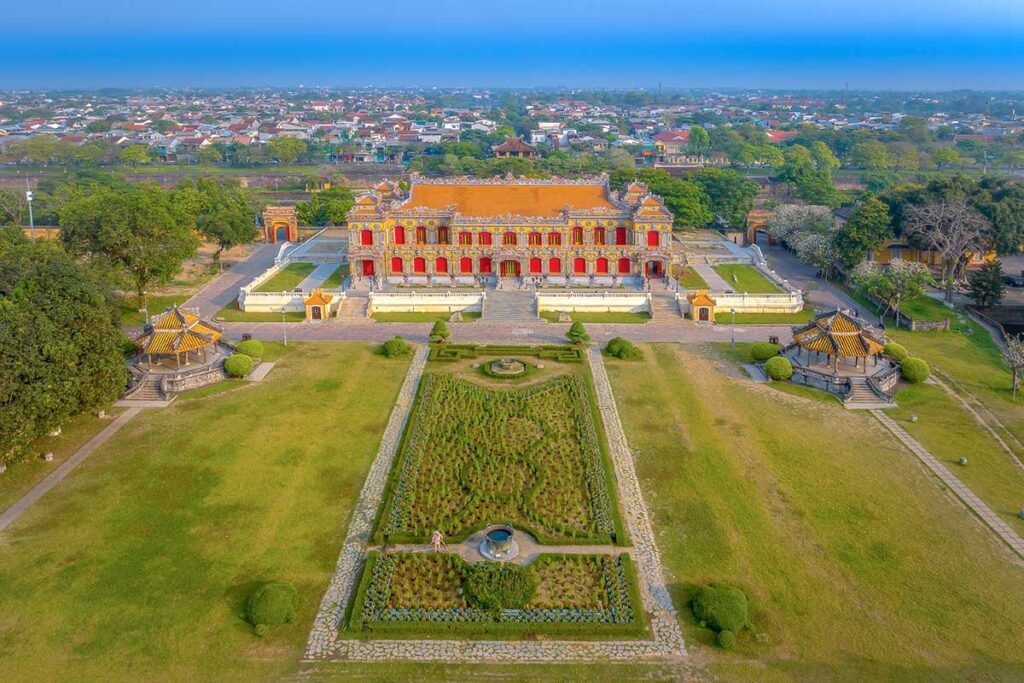
The original building was destroyed during the First Indochina War, and only its foundations survived for decades. The version seen today is a full reconstruction completed in 2023, with porcelain mosaics, yellow-glazed tiles, and landscaped gardens recreated in detail. Its location on the central axis of the Forbidden Purple City reflects its importance in the Nguyen court, while its European-inspired style sets it apart from the older wooden palaces nearby.
History of Kien Trung Palace
Early constructions on the site
Long before Kien Trung Palace existed, this spot in the Forbidden Purple City was home to other royal buildings. In 1827, during the reign of Emperor Minh Mang, the Minh Viễn Pavilion was built — a large three-storey wooden structure used for enjoying views and fresh air. It was considered one of the most beautiful scenes in the imperial capital, but by the 1870s it had deteriorated and was dismantled. In 1913, Emperor Duy Tân had a simpler two-storey building constructed here, known as the Du Cửu Pavilion.
Khai Dinh’s construction (1921–1923)
When Emperor Khai Dinh took the throne in 1916, Vietnam was under strong French colonial influence. In 1921, he ordered the demolition of the Du Cửu Pavilion to make way for a new residence — Kien Trung Palace. Unlike the wooden palaces of previous reigns, this was built from concrete and designed with a blend of French, Italian Renaissance, and traditional Vietnamese styles. It included modern features rare in Vietnam at the time, such as indoor plumbing and electric lighting, reflecting the emperor’s interest in European architecture and technology.
Bao Đai era
After Khai Dinh’s death in 1925, his son Bảo Đại became emperor and moved into Kien Trung Palace with his wife, Empress Nam Phương — breaking the tradition that the emperor and empress lived separately. Their son, Crown Prince Bảo Long, was born here in 1936. The palace also became the setting for one of Vietnam’s most important political moments: in August 1945, Emperor Bảo Đại met a delegation from the new revolutionary government here to discuss his abdication, marking the end of Vietnam’s monarchy.
Destruction (1947)
Just two years later, during the First Indochina War between the French and the Viet Minh, heavy fighting reached Hue. In 1947, Kien Trung Palace was almost completely destroyed. Only parts of the balustrade and foundation were left, and for decades the site remained an empty shell within the Imperial City.
Reconstruction (2019–2023)
In 2019, the Hue Monuments Conservation Centre began a major restoration project to rebuild Kien Trung Palace as it looked in the 1920s. The work took five years and cost the equivalent of over 5 million USD. Artisans used archival photos, architectural drawings, and historical descriptions to recreate the details, from the yellow-glazed roof tiles to the intricate porcelain mosaics. Surrounding features such as gardens, fountains, and guardhouses were also restored. The palace reopened to the public in early 2024, once again occupying its place on the Imperial City’s central axis.
Understanding its place in the Imperial City
Before visiting Kien Trung Palace, it helps to understand the layout of Hue’s historic core. The Imperial City was built with a strict hierarchy of spaces, and knowing where the palace fits into this plan makes its role much clearer.
- Hue Citadel – A large walled fortress built in the early 1800s to protect the Nguyen Dynasty’s seat of power. It has thick defensive walls, a moat, and several gates leading to the inner areas.
- Hue Imperial City – Located inside the Citadel walls, this was the administrative and ceremonial heart of the dynasty, containing government halls, royal shrines, and official residences.
- Forbidden Purple City – The most private area within the Imperial City, reserved for the emperor, his family, and close attendants. Access was strictly controlled, and even high-ranking officials needed permission to enter.
Kien Trung Palace stood at the northern end of the Forbidden Purple City, directly on the central axis that connected the emperor’s working halls with his living quarters. Its prominent position reflected both its importance as the monarch’s residence and its role in major events during the Nguyen Dynasty’s final years.
Highlights of visiting Kien Trung Palace today
What you see today is not the original building, but a careful reconstruction completed in 2023. The restoration aimed to follow historical records as closely as possible, using photographs, drawings, and original materials where available. While it inevitably lacks the patina of age, it gives a clear impression of how the palace looked in the 1920s and restores its place in the Imperial City’s central axis.
1. Exterior architecture
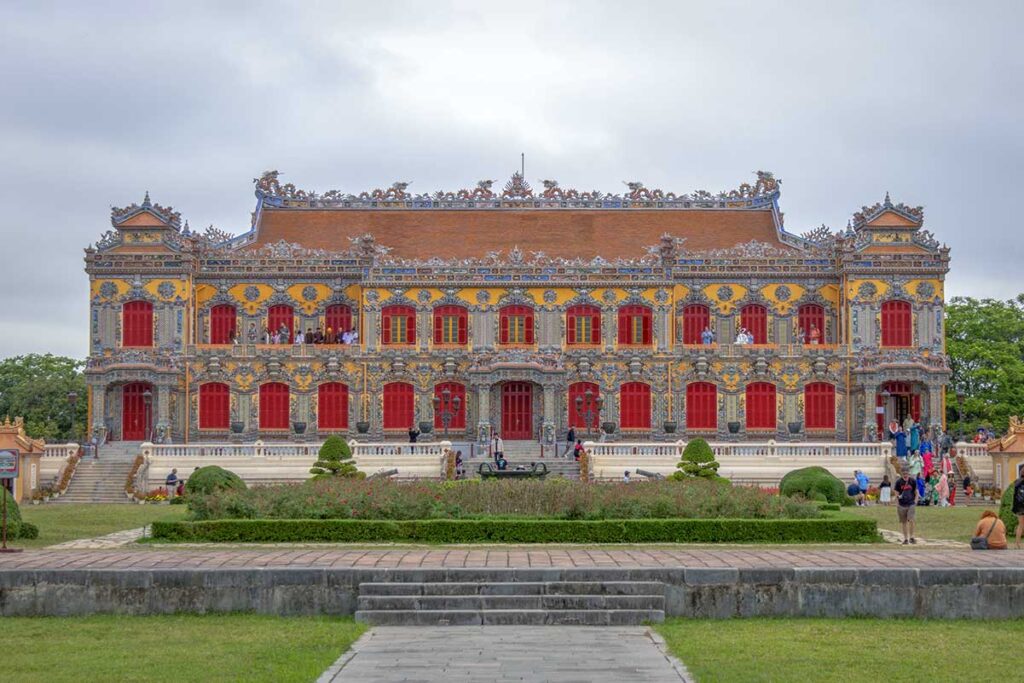
The palace faces south, with a long façade decorated in porcelain mosaics depicting dragons, roosters, flowers, and other symbolic motifs.
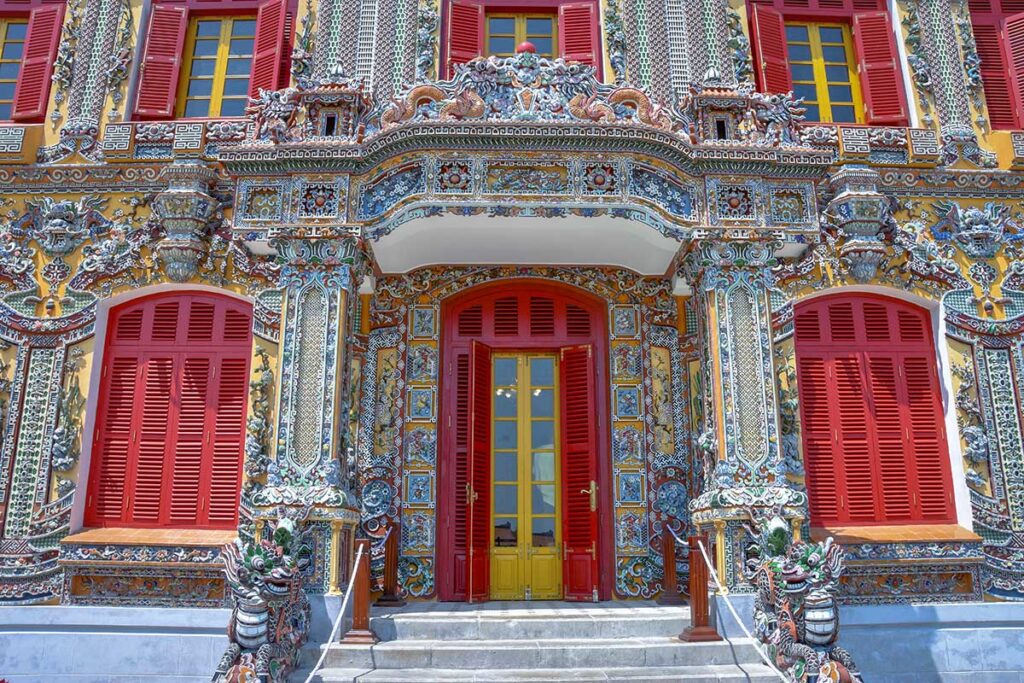
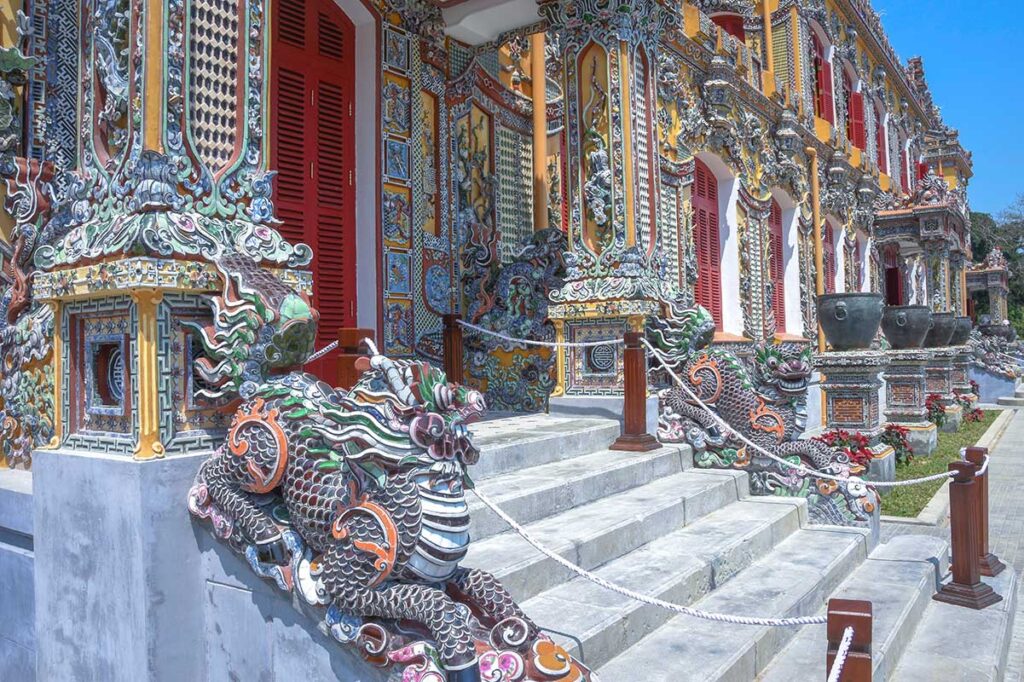
A French-style balustrade runs along both levels, and three staircases lead up to the entrance, each guarded by dragon or snake designs in stone. In front is a formal garden with geometric Art Deco patterns, linking the palace to both Vietnamese and European design traditions.
2. Interior design & Rooms
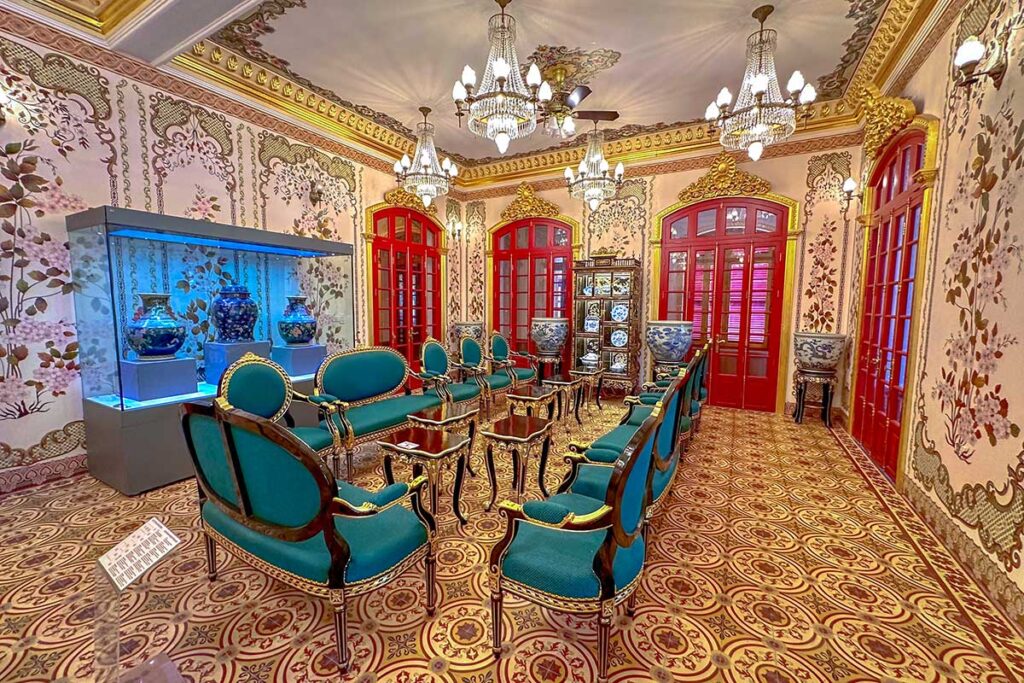
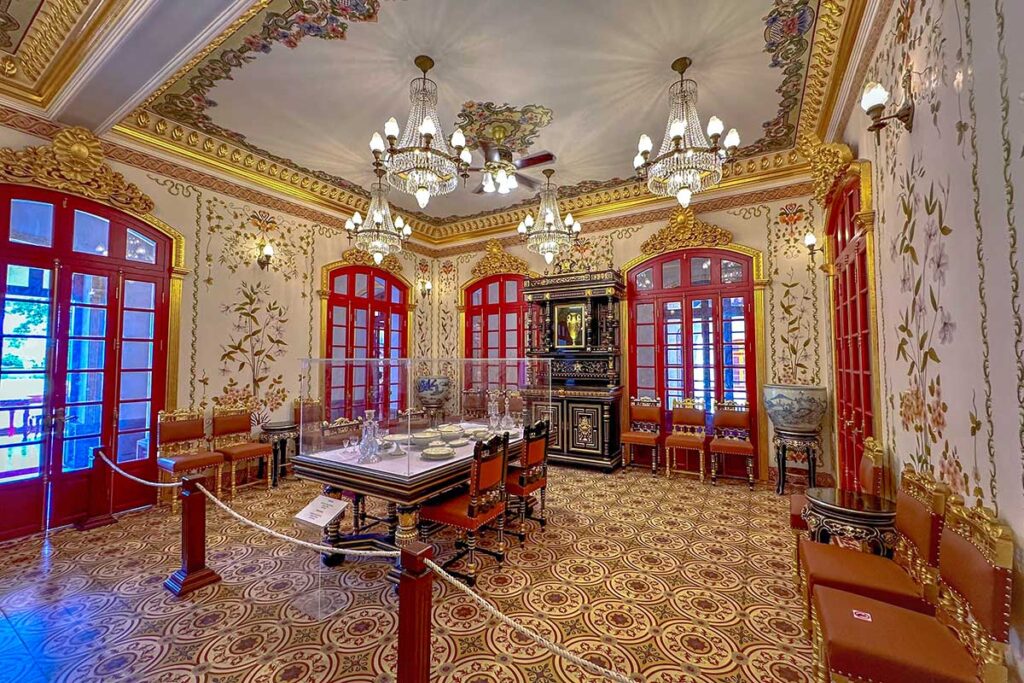
Inside, the halls are restored with bright period-style colours and detailed decorative motifs. Carved woodwork, painted ceilings, and patterned floor tiles recreate the atmosphere of a royal residence during the Nguyen Dynasty’s final years. The layout is formal and symmetrical, with rooms arranged for both ceremonial and private use.
3. Antiques & Displays
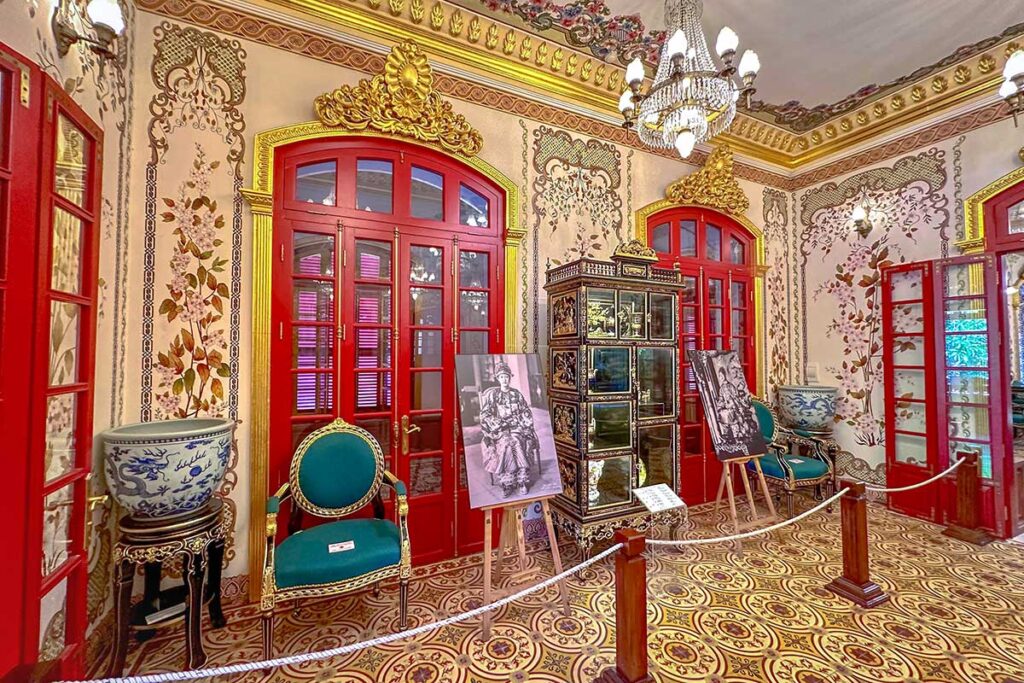
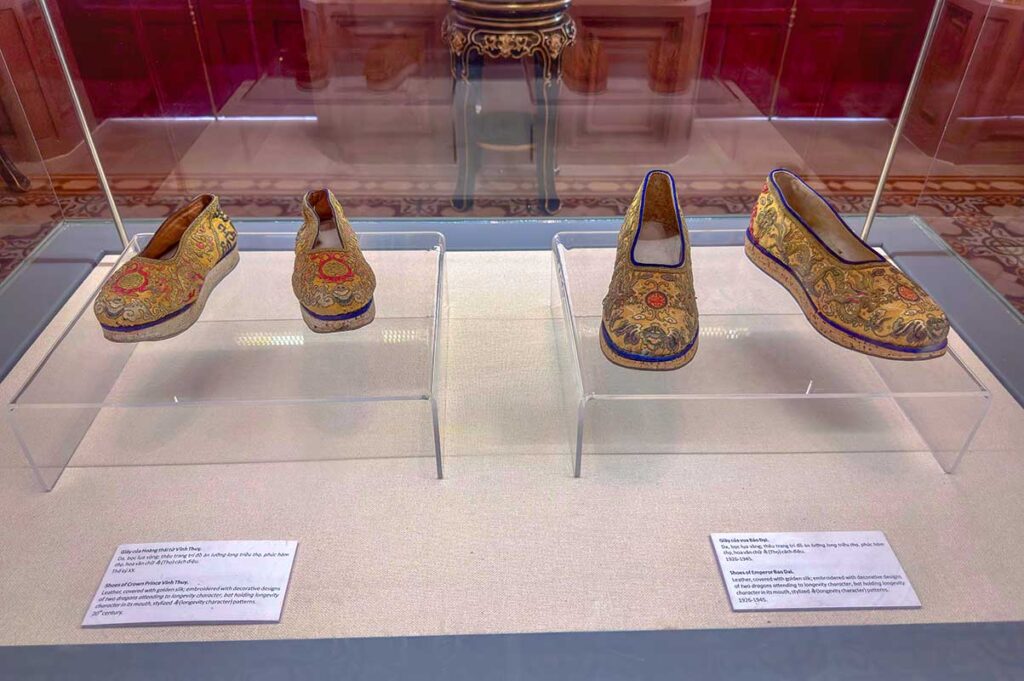
The ground floor houses displays of original and period-appropriate objects from the reigns of Khai Dinh and Bao Dai. These include porcelain, bronze items, royal clothing, and a palanquin once used by Khai Dinh. While the collection is not as extensive as in Hue’s dedicated museums, it helps connect the restored building to the people who once lived here.
4. Upper floor exhibits
The upper floor sometimes hosts temporary exhibitions, such as art displays or themed collections related to Hue’s imperial history. These change over time, so the experience can be different depending on when you visit.
5. Surrounding details
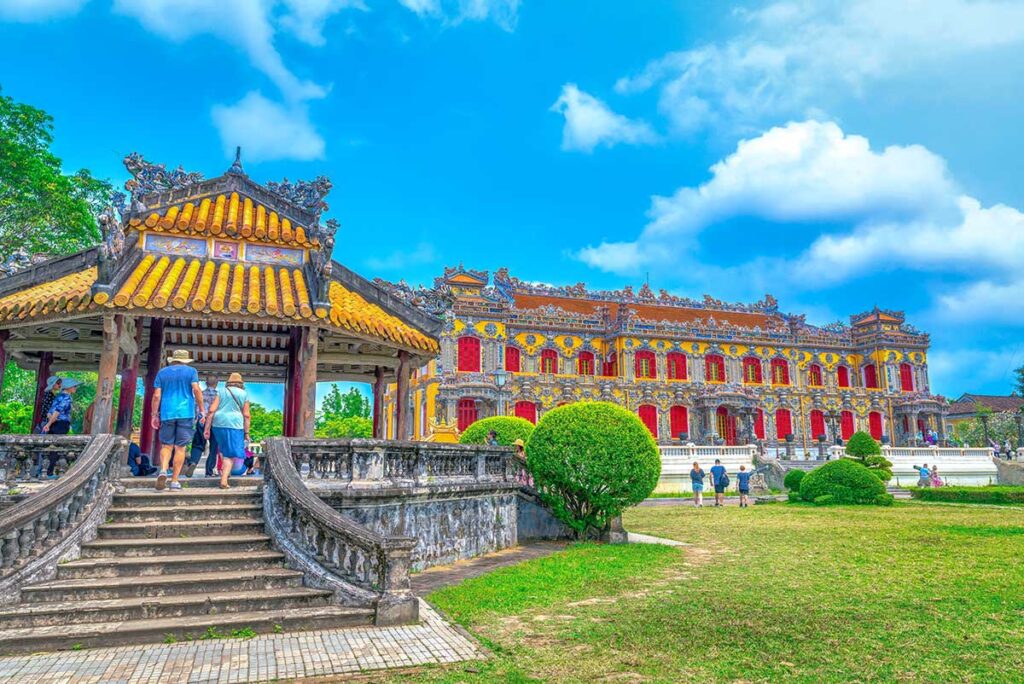
Beyond the main building, the reconstruction included features such as fountains, cannon platforms, and small guardhouses, as well as landscaped gardens. These details help recreate the setting of the palace as part of the larger Forbidden Purple City, rather than as a stand-alone monument.
Visiting information
Location & Access
Kien Trung Palace is located inside the Forbidden Purple City, at the northern end of the Imperial City’s central axis. The main entrance of the Imperial City is through the Ngo Mon Gate, then walk past Thai Hoa Palace, and continue straight through successive courtyards until reaching the palace. Signs within the complex make it easy to find, but allow time for walking, as the Imperial City covers a large area.
Tip: Our full-day Hue tour includes the Imperial City, two royal tombs, a dragon boat trip, and Thien Mu Pagoda.
Hue Historical City Tour
- Highlights: Hue Imperial City, royal tombs, Perfume River cruise, Dong Ba Market.
- Options: Small-group tour or private tour
Opening hours & Tickets
The palace is included in the Hue Imperial City entrance ticket.
- Opening hours:
- Summer (Apr–Sep): 06:30 – 17:30
- Winter (Oct–Mar): 07:00 – 17:00
Tickets can be bought at the main gates of the Imperial City or online through official channels.
Time Needed
Allow 20–30 minutes to explore Kien Trung Palace itself. To visit the whole Imperial City at a relaxed pace, plan for at least half a day, or longer if you want to explore in detail.
Dress code & Conduct
While there is no strict dress code, modest clothing is recommended out of respect for the historical and ceremonial nature of the site. Avoid touching artifacts or leaning on decorative surfaces. Photography is generally allowed, but some interior areas may have restrictions on flash or video.
Nearby sights
Kien Trung Palace can easily be combined with other restored sites in the Imperial City, including:
- Thai Binh Pavilion – Decorative royal retreat with intricate mosaics and gardens.
- Hue Royal Theatre – Venue for traditional music and dance performances.
- Dien Tho Palace – Residence of the empress mothers.
- To Mieu Temple Complex – Dedicated to the Nguyen emperors and home to the Nine Dynastic Urns.
Practical tips
- Avoiding peak hours: Visit early in the morning or later in the afternoon for fewer crowds.
- Best light for photography: Early morning provides softer light on the palace façade.
- Heat management: The interior has limited air flow; take breaks outside or bring water on hot days.
- Guided tours: Joining a guided Imperial City tour can give deeper context to Kien Trung Palace and other structures.
- Costume rental: Traditional Vietnamese costumes (ao dai, nhat binh, and others) can be rented at Huu Vu, behind Thai Hoa Palace, or on the palace’s ground floor.
